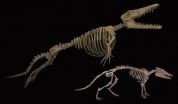(Press-News.org) BLOOMINGTON, Ind. -- Rapid advances in the new and developing field of restoration sedimentology will be needed to protect the world's river deltas from an array of threats, Indiana University Bloomington geologist Douglas A. Edmonds writes in the journal Nature Geoscience.
The commentary, published this week in the November issue, addresses the fact that land is disappearing from river deltas at alarming rates. And deltas are extraordinarily important: They are ecologically rich and productive, and they are home to about 10 percent of the world's population.
"There's a lot of talk about ecological restoration of the coast," Edmonds said. "But with delta environments, before ecological restoration can happen you have to stabilize the coastline."
Under naturally occurring processes, coastal land is both created and destroyed at river deltas. River sediment is deposited at the delta, building land. Erosion takes some of the land away. The rate of land growth or loss depends on the balance between "sources" and "sinks," which is influenced by the complex interaction of floods, ocean waves and tides, vegetative decay and wind.
But sea-level rise and coastal subsidence have tilted the scales toward land loss, and dams and levees built for flood control have interfered with the delivery of sediment. In the Mississippi River delta, the chief focus of the article, an expanse of land the size of a football field disappears every hour.
Edmonds says there is potential for restoring deltas by designing river diversions that direct sediment from rivers to areas where it can do the most good.
"The main challenges for restoration sedimentology," he writes, "are understanding the sources and sinks, and predicting the rate of land growth under any given river diversion scenario."
For example, river sediment must be deposited near the shore, not carried into the deep ocean, to help create land. Hurricanes and waves carry away that sediment in some circumstances but in others they encourage deposition.
Because of dams and flood-control barriers, the Mississippi River doesn't appear to carry enough sediment to offset sea-level rise and coastal subsidence. "From today's perspective," Edmonds says, "the future of the Mississippi River delta is grim. But river diversions have proven successful, and there is a lot we don't know about the sedimentological processes of land-building that may change projections."
For instance, much remains to be learned about the interaction of forces that affect delta sedimentology. The "most significant unknown," he says, is the contribution of organic matter from decomposing plants to land building -- it is estimated to be as high as 34 percent in the Mississippi delta.
"The idea is to better understand the pathways by which sedimentology constructs delta land and the sinks by which that land is lost," Edmonds said. "It's all about that balance. And the more we know, the better we can engineer scenarios to tip the balance in favor of building land as opposed to drowning land."
Edmonds holds the Robert R. Schrock Professorship in Sedimentary Geology and is an assistant professor in the IU Bloomington Department of Geological Sciences in the College of Arts and Sciences. His research focuses on the sedimentology, stratigraphy and geomorphology of depositional systems, which he studies using mathematical modeling, field observation and occasionally experimentation.
INFORMATION:
The Nature Geoscience commentary is available online. To speak with Edmonds, contact Steve Hinnefeld at IU Communications, 812-856-3488 or slhinnef@iu.edu.
Geologist calls for advances in restoration sedimentology
2012-11-07
ELSE PRESS RELEASES FROM THIS DATE:
In the digital age, managers can't ignore #angrycustomers
2012-11-07
CHESTNUT HILL, MA (November 7, 2012) – In a digital age where dissatisfied consumers vent their concerns through biting viral videos, nasty blog posts or negative online comments, managers need to develop strategies to soothe angry customers in person as well as online, according to a new study in the latest edition of the Journal of Service Research.
In a study that explores the changing ways in which customers express their emotions, the researchers found that anger can quickly fuel negative word-of-mouth commentary to fellow consumers, family and friends, as well as ...
Protein reveals diabetes risk many years in advance
2012-11-07
When a patient is diagnosed with type 2 diabetes, the disease has usually already progressed over several years and damage to areas such as blood vessels and eyes has already taken place. To find a test that indicates who is at risk at an early stage would be valuable, as it would enable preventive treatment to be put in place.
Researchers at Lund University have now identified a promising candidate for a test of this kind. The findings have been published in the journal Cell Metabolism.
"We have shown that individuals who have above-average levels of a protein called ...
Persistent sync for neurons
2012-11-07
A team of Brazilian physicists working with neuroscientists studying freely behaving rats have found that their neurons often act in precise coordination over time, in a study about to be published in EPJ B. These findings stem from the work of Bruno Silva, a researcher at Bahia Federal University in Salvador, and his colleagues from other universities in the Northeastern region of Brazil, and suggest that neuronal networks' memory could be explored in the future.
Because neurons are connected with each other, acting as operational units in the brain, they can be considered ...
City birds adapt to their new predators
2012-11-07
Faced with the same threat, city and country birds do not react in the same way despite being from the same species. According to a new study, urban birds have changed their anti-predator behaviour in new environments.
When a bird is faced with a predator, its only objective is to escape. However, city birds do not react in the same way as their countryside counterparts, despite being from the same species. Urbanisation plays an influential role in their survival strategies.
To study this phenomenon, Juan Diego Ibáñez-Álamo, researcher at the University of Granada ...
Ultrasensitive photon hunter
2012-11-07
Fast and ultrasensitive optical systems are gaining increasing significance and are being used in a diverse range of applications, for example, in imaging procedures in the fields of medicine and biology, in astronomy and in safety engineering for the automotive industry. Frequently the challenge lies in being able to record high-quality images under extremely low light conditions. Modern photo detectors for image capture typically reach their limits here. They frequently work with light-sensitive electronic components that are based on CMOS (Complementary Metal Oxide ...
Dealing with power outages more efficiently
2012-11-07
Power supply is the backbone of our modern economy. Nearly every aspect of life depends on electrically-operated devices. When the flow of power stops, it is not just the lights that go out. In the supermarket, the automatic teller machines and cash registers stop working. Even telephones, radios and televisions become paralyzed. If the shortage lasts a long time the supply of hot water, gas and fuel and the functioning of respirators at intensive care units in nursing homes or at private homes is at risk.
The causes of this dreadful scenario can range from natural disasters ...
Activating the 'mind's eye' -- sounds, instead of eyesight can be alternative vision
2012-11-07
Jerusalem, Nov. 7, 2012 -- Common wisdom has it that if the visual cortex in the brain is deprived of visual information in early infanthood, it may never develop properly its functional specialization, making sight restoration later in life almost impossible.
Scientists at the Hebrew University of Jerusalem and in France have now shown that blind people – using specialized photographic and sound equipment – can actually "see" and describe objects and even identify letters and words.
The new study by a team of researchers, led by Prof. Amir Amedi of the Edmond and ...
Protected areas in East Africa may not be conserving iconic plants
2012-11-07
A new study led by researchers from the University of York suggests protected areas in East Africa are not conserving plants such as the iconic Acacia tree.
Acacia, the thorny flat-topped tree that characterises the African savannas, is an important component of ecosystem diversity. However, the researchers found that the majority of Acacia biodiversity 'hotspots' receive little protection through the protected area network, which includes national parks, nature and forest reserves. The situation, they say, may be exacerbated by climate change.
The results of the study, ...
Development of measures to prevent wine indispositions
2012-11-07
Biogenic amines may be one of the factors responsible for symptoms such as headaches, gastro-intestinal disorders, shortness of breath, fall in blood pressure, and even unconsciousness and cardiac arrhythmia in severe cases. Histamine, one of the best known members of this group, can cause serious physical problems. Biogenic amines can be produced in the body by natural metabolic activities but are also ingested in larger quantities with food. They play a special role in microbiologically produced food such as wine, beer, cheese, and sauerkraut. In a joint project Johannes ...
Recent studies bring fossils and genes together to piece together evolutionary history
2012-11-07
Paleontology, with its rocks and fossils, seems far removed from the world of developmental genetics, with its petri dishes and embryos. Whereas paleontology strives to determine "What happened in evolution?", developmental genetics uses gene control in embryos to try to answer "How did it happen?" Combined, the two approaches can lead to remarkable insights that benefit both fields.
In the current issue of the Journal of Vertebrate Paleontology, Hans Thewissen, Ingalls-Brown Professor at Northeast Ohio Medical University (NEOMED), and his colleagues review recent studies ...





